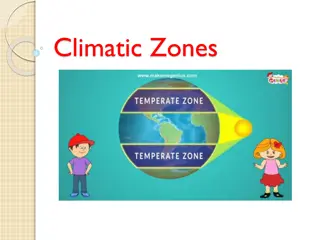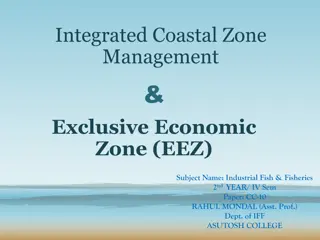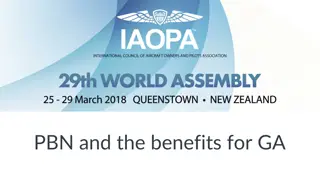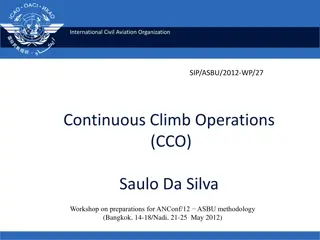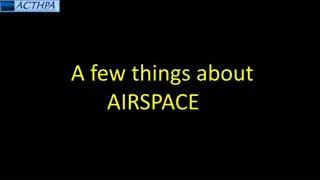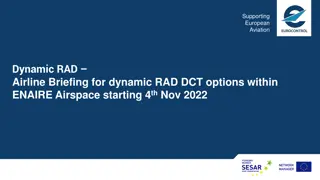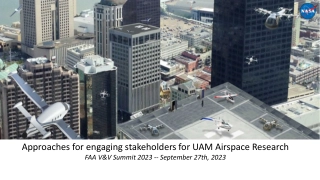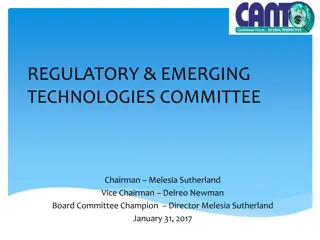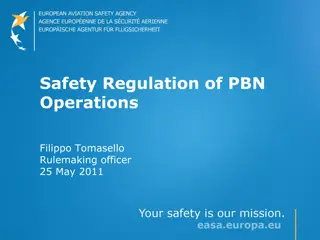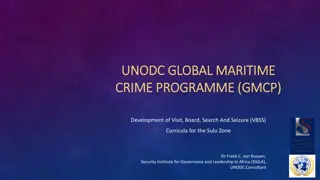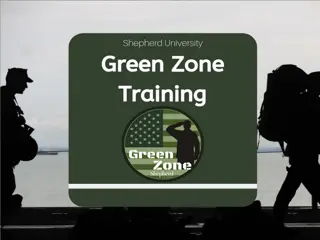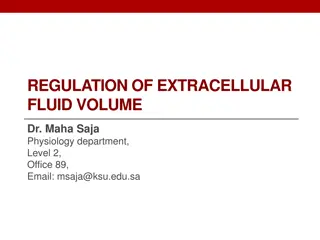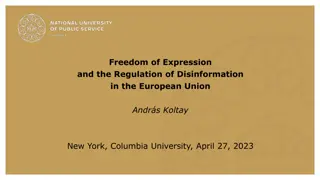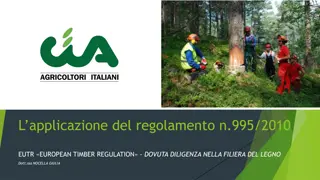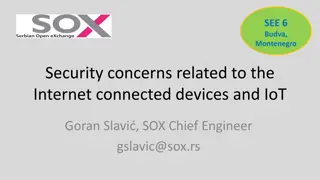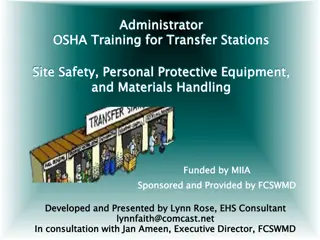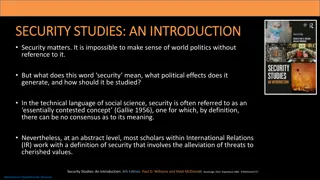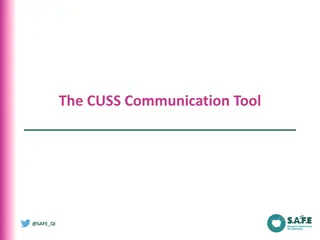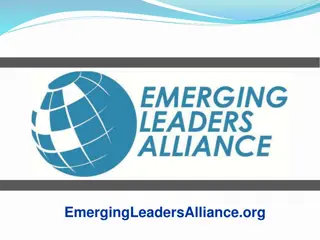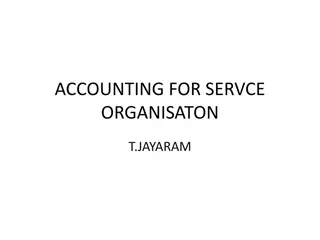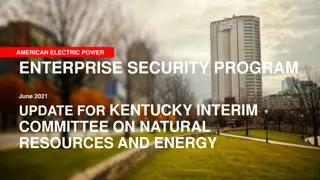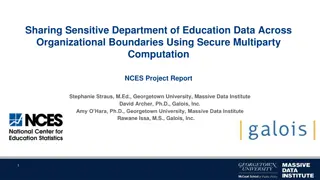Emerging Security Concerns in the Proto-zone: A Closer Look at Airspace Management and Regulation
Contextualizing the evolving challenges in the Proto-zone above commercial airspace, this article delves into the importance of formal consideration by space legal experts. With the rise of technologies like hypersonic transports, stratospheric balloons, and dark sky research stations, there is a growing need for Protospace traffic management, pollution control, and coordinated use of this critical region. The discussion also touches on the implications of historical events, such as the U-2 incident, on the altitude at which nations assert control over their skies and underscores the significance of international agreements like the Law of the Sea Convention in defining territorial boundaries.
Download Presentation

Please find below an Image/Link to download the presentation.
The content on the website is provided AS IS for your information and personal use only. It may not be sold, licensed, or shared on other websites without obtaining consent from the author. Download presentation by click this link. If you encounter any issues during the download, it is possible that the publisher has removed the file from their server.
E N D
Presentation Transcript
Urgent Security Concerns in the Proto-zone http://216.70.82.181/new-blog/wp-content/uploads/2010/06/world.jpg Joseph N. Pelton, Executive Board, International Association for the Advancement of Space Safety
Book by D. Loth and M. Ernst How High is Up? is a Useful Starting Point Loth and Ernst look at the skies in terms of geopolitics. They see a country s ability to command their air space as being key. They see this as the true basis for any subsequent regulatory or legal jurisdiction. Weapons systems that advanced from arrows, catapults, guns and cannons to today s aircraft and missiles have served to ultimately increase the altitude of the airspace that a nation controls. Today commercial airspace up to 21 Km is well regulated and subject to air traffic control. This area is coordinated globally by the International Civil Aviation Organization (ICAO) under the Chicago Convention of 1948 and updated via Standards and Recommended Practices (SARPs). From the perspective of Loth and Ernst, the U-2 incident where Gary Powers U.S. spy plane was shot down by the Soviet Union changed How High Is Up. As a practical matter, this event meant that a nation s protected air space would ultimately rise to a higher altitude as international law followed the real politik reality of the latest capability of armaments to protect a nation s skies.
Todays New Problem-The Proto-zone The area above commercial airspace, i.e. 21 Km and below the area that can allow satellites to stay in orbit above Earth, i.e. 160 Km is finding more and more applications and this region needs to be considered formally by space legal experts. Uses of this region include stable high altitude and stratospheric craft such as aerostats, Unmanned Aerial Systems (UAS), High Altitude Platform Systems (HAPS), and so-called dark sky research and relay stations. These stable non velocity systems are in contrast to systems travelling at altitude, i.e. robotic stratospheric freighters, space planes, hyper sonic or super sonic aircraft, or military craft. There is much discussion about the need for space traffic management and control, but there is an equal need to establish Protospace traffic management and control and coordinated use of this region that has increasing levels of use. There is the additional element of concern for pollution to the stratosphere, especially with space planes with solid fuels.
Bristol Ascender Hypersonic Transport
Google Solar Powered Stratospheric Balloons for Internet Relay
Prototype of Dark Sky Station by JP Aerospace
The Law of the Sea Convention The Law of the Sea Convention of 1982 establishes a broad global basis for agreement on territorial waters (12 nautical miles or 22.2 Km), Contiguous Zone (24 nautical miles) and Exclusive Economic Zone (up to 200 nautical miles) This might serve as a useful way to consider the national claims to the control and use of the Protozone as a conceptual precedent. This would leave national commercial air space control and management at an altitude up to 21 Km. Create a Vertical Strategic Contiguous Zone to perhaps 42 Km altitude, and finally a Stratospheric Economic Zone (42 Km to 160 Km).
Key Issues & Concern 1 The regulation and control of the Protozone involves more that strategic security and air traffic control and management. At the international level there is not only the logical involvement of UNODA for defense-related issues and ICAO for air safety coordination. In addition there is also the ITU with regard to radio frequency allotment. Further there is the issue of stratospheric pollution that involves the WMO and the UNEP, and even the World Health Organization as to radiation hazards and standards.
Key Issue Number 2: There is a question of where national control of these various Protozone related areas begin and end. Do they start at 12 nautical miles off shore or perhaps begin at 200 nautical miles off shore? Even if there is agreement to start regulating Protozones it is not only how high does control goes, but also how far off shore does control begin or end?
Key Issue Number 3: In addition to the question of regulatory and legal provisions for the safe and harmonious use of the Protozone, there are also key technical issues that need to be addressed. These issues involve improvements and changes to software for satellite navigation systems because of imprecisions that occur between ground level positioning calculations versus aircraft of various types at altitudes up to 160 Km and also the functionality of radar systems at stratospheric altitudes. The technical problems to date have largely not been specifically addressed and may be more challenging than regulators and political officials today clearly understand.
Restrictions against the Deployment and Use of Weapon Systems in the Protozone as well as in Outer Space The Outer Space Treaty explicitly restricts the deployment of weapons in space. The simplest approach to Protospace would be to prohibit the deployment of weapons in the Proto-zone as well. There is today no clarity as to what the status of missile firings, including those armed with warheads, that travel in sub-orbital arcs through the Protozone . This is the number one unresolved issue that will ultimately have to be addressed. Further there are questions about remote sensing or surveillance satellites that are used for targeting of missiles and bombs, or communications satellites that are used to provide tactical support to drones or UAVs in order to deploy bombs or weapons systems.
Restrictions related to weapons systems in Proto-Zone Clearly as new space systems such as directed energy systems, high powered lasers, and other new systems are developed that might be deployed in outer space or in the Protozone , there will be many new challenges to be addressed. The point is that efforts to define space weapons should include recognition that we are now really addressing restrictions on space and protozone weapons systems rather than just military systems in outer space.
Liability Convention is a problem It is over a half century old and is not equipped to cope with problem of private ownership of spacecraft and transfer of ownership . It is not equipped to address problem of orbital debris and its build up and in-orbit servicing and active debris removal It is not equipped to address issue of deployment of systems designed for long term efforts to cope with the orbital debris like Electro Dynamic Debris Eliminator (EDDE).
Traffic Control for Proto-zone may need not only new regulation but also may need new technical capabilities. One of the elements that seems to have been overlooked in the consideration of the new applications for the Proto-zone is the fact that there is a need for at least 3 things: (i) new regulations, laws and safety standards, (ii) new commercial arrangements; (iii) new technical capabilities to implement these new controls. The GPS and other space navigation satellite systems were designed for determining positioning and targeting on the ground or relatively low altitudes. There were not designed for space traffic management or even precise guidance and control at stratospheric altitudes. The ability to modulate the accuracy of space navigation systems to provide for space traffic management and control and for the Proto-zone or near space traffic management and control is something that needs careful review and analysis. This may be a matter of developing software or declassifying software that adjusts automatically to altitude or some other adept programming adjustment. This may also require upgrades on changes to the technical specification of the new S band Radar Space Fence being deployed in the Pacific.
When Space Traffic Management and Control is discussed, the implications and processes for the Protozone must be considered The safety considerations and problems in the Protozone are large. There are very great relative speed and likelihood of greater density of operations. The low or zero velocity of UAS, UAV, HAPS and dark sky stations for commercial and strategic applications must occupy Protozone locations that may also be inhabited by robotic freighters and supersonic, hypersonic and spaceplane craft being used for commercial, governmental and defense-related purposes.
Priority Issues Definition of the Protozone and perhaps definition of new spaces based on Law of the Sea precedence in terms of national control and regulatory authority for this region. Recognition that discussion of space traffic management and control needs to include consideration of the Protozone . In this regard it needs to be recognized that there are not only issues of regulation but the possible need for new technical capabilities equipment and software. Discussion of deployment of space weapons also needs to explicitly include the Protozone Liability Convention issues and problems also include consideration of how this relates to the Protozone Recognition that as far as UN specialized agencies are concerned that this involves not only ICAO, but also such agencies as ITU, WHO, UNEP, WMO, UN COPUOS, and UNODA


